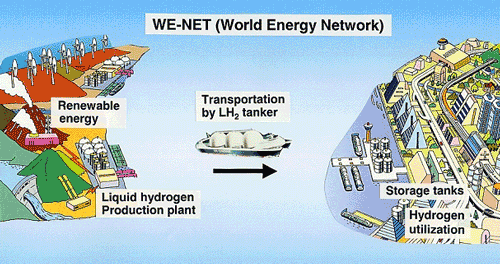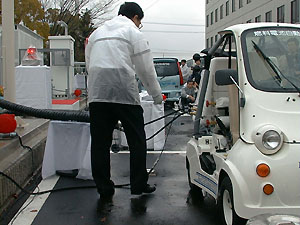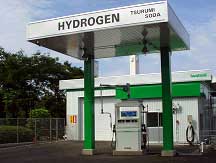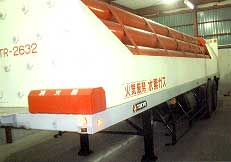WE-NET Project completed/
Hydrogen Refueling Station
WE-NET Project completed
WE-NET (World Energy Network: International cooperation in research and development of clean energy system with particular emphasis on hydrogen) was initiated in 1993 with an objective to enable introduction of a world-wide network for development of abundantly available renewable resources such as water, solar energy, wind power, etc, for transportation of the reusable energy to where needed, and for utilization of the energy in variety such as for power generation, fuels, city gas, etc. It was expected to contribute to solving world wide problems in energy and environmental issues through reduction of greenhouse gases and provision of a buffer for demand and supply of international energy field.
 R&D in the first phase, which lasted for 6 years until 1998, was based on a long term concept in utilization of hydrogen. It was tried to develop core technologies indispensable for construction of a network for supply and demand of hydrogen as the secondary and reusable energy.
R&D in the first phase, which lasted for 6 years until 1998, was based on a long term concept in utilization of hydrogen. It was tried to develop core technologies indispensable for construction of a network for supply and demand of hydrogen as the secondary and reusable energy.
After then, thorough review on the overall project concept was made, and the second phase of WE-NET started in 1999. It was intended to introduce concepts in the short and medium term as well (realization, promotion and actual introduction of hydrogen energy into human society) although they should be based on the long-term concept in the first phase. It was also intended to further develop hydrogen sources and to apply a policy to emphasize hydrogen technology in its wide application. The second phase in WE-NET was completed one year ahead of schedule in 2002, and was succeeded by a new projectgDevelopment of Fundamental Technologies in the Safe Utilization of Hydrogenh, which will be starting from 2003.
"Development of Fundamental Technologies in the Safe Utilization of Hydrogen"is implemented as a part of "Hydrogen Energy Application Program as Proton-exchange membrane fuel cell", which is to enhance earlier commercialization of solid high molecule fuel cell in order to attain stabilized energy supply system, to improve energy efficiency, to solve global warming(CO2) and environmental issues (NOx, PM, etc.), to introduce new industries for creation of employment opportunities, and to realize hydrogen energy society.
In a word, all the achievements made through 10 year WE-NET Project will be reflected to this newly born project.
Hydrogen Refueling Station completed at 3 locations
WE-NET has been devoting all of its efforts to developing the infrastructure for hydrogen. On February 7, 2002, the first Hydrogen Refueling Station in Japan was installed in Osaka. At the ceremony for completion, hydrogen supply to fuel cell vehicle was demonstrated, giving a premonition of the arrival of hydrogen society. This station is natural gas reforming type.
Then the second Hydrogen Refueling Station was installed in Takamatsu city, Kagawa Prefecture, and the ceremony for completion was held on February 28, 2002. Despite the wet weather, many enthusiastic participants attended the startup ceremony and the demonstration of hydrogen supply to fuel cell vehicle. This station is water electrolysis type with a solid polymer membrane to generate hydrogen.
Then the second Hydrogen Refueling Station was installed in Takamatsu city, Kagawa Prefecture, and the ceremony for completion was held on February 28, 2002. Despite the wet weather, many enthusiastic participants attended the startup ceremony and the demonstration of hydrogen supply to fuel cell vehicle. This station is water electrolysis type with a solid polymer membrane to generate hydrogen.
At Hydrogen Refueling Stations, trial operations will be performed for experiment and research that are necessary for practical application, such as verification and evaluation of performance in continuous operation, and confirmation of parameter variation over time. Additionally, optimum conditions for hydrogen loading will be determined and safe operation system for Hydrogen Refueling Station will be verified. Also, based on these knowledge, guidelines for safety and design will be prepared, which will lead to standard specifications for Hydrogen Refueling Stations in the future.
Copyright(C) 1998-2003 New Energy and Industrial Technology Development Organization


 R&D in the first phase, which lasted for 6 years until 1998, was based on a long term concept in utilization of hydrogen. It was tried to develop core technologies indispensable for construction of a network for supply and demand of hydrogen as the secondary and reusable energy.
R&D in the first phase, which lasted for 6 years until 1998, was based on a long term concept in utilization of hydrogen. It was tried to develop core technologies indispensable for construction of a network for supply and demand of hydrogen as the secondary and reusable energy.




